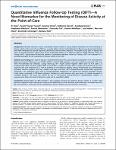Quantitative Influenza Follow-Up Testing (QIFT)—A Novel Biomarker for the Monitoring of Disease Activity at the Point-of-Care
Chen, Xi
Yousef, Kaveh Pouran
Duwe, Susanne
Karsch, Katharina
Grover, Sandeep
Wählisch, Stephanie
Obermeier, Patrick
Tief, Franziska
Mühlhans, Susann
Seeber, Lea
Kleist, Max von
Schweiger, Brunhilde
Rath, Barbara
Background: Influenza infections induce considerable disease burden in young children. Biomarkers for the monitoring of disease activity at the point-of-care (POC) are currently lacking. Recent methodologies for fluorescence-based rapid testing have been developed to provide improved sensitivities with the initial diagnosis. The present study aims to explore the utility of second-generation rapid testing during longitudinal follow-up of influenza patients (Rapid Influenza Follow-up Testing = RIFT). Signal/control fluorescent readouts (Quantitative Influenza Follow-up Testing = QIFT) are evaluated as a potential biomarker for the monitoring of disease activity at the POC. Methods and Findings: RIFT (SOFIA) and QIFT were performed at the POC and compared to blinded RT-PCR at the National Reference Centre for Influenza. From 10/2011-4/2013, a total of 2048 paediatric cases were studied prospectively; 273 cases were PCR-confirmed for influenza. During follow-up, RIFT results turned negative either prior to PCR (68%), or simultaneously (30%). The first negative RIFT occurred after a median of 8 days with a median virus load (VL) of 5.6×10∧3 copies/ml and cycle threshold of 37, with no evidence of viral rebound. Binning analysis revealed that QIFT differentiated accurately between patients with low, medium and high viral titres. QIFT increase/decrease showed 88% agreement (sensitivity = 52%, specificity = 95%) with VL increase/decrease, respectively. QIFT-based viral clearance estimates showed similar values compared to PCR-based estimates. Variations in viral clearance rates were lower in treated compared to untreated patients. The study was limited by use of non-invasive, semi-quantitative nasopharyngeal samples. VL measurements below the limit of detection could not be quantified reliably. Conclusions: During follow-up, RIFT provides a first surrogate measure for influenza disease activity. A “switch” from positive to negative values may indicate a drop in viral load below a critical threshold, where rebound is no longer expected. QIFT may provide a useful tool for the monitoring of disease burden and viral clearance at the POC.
No license information

